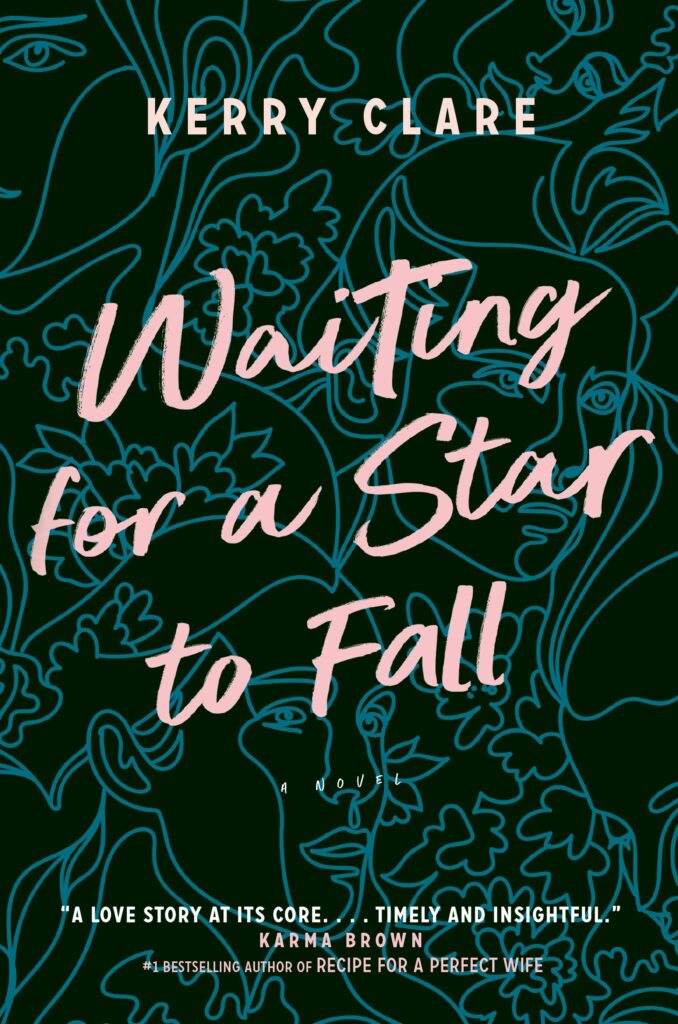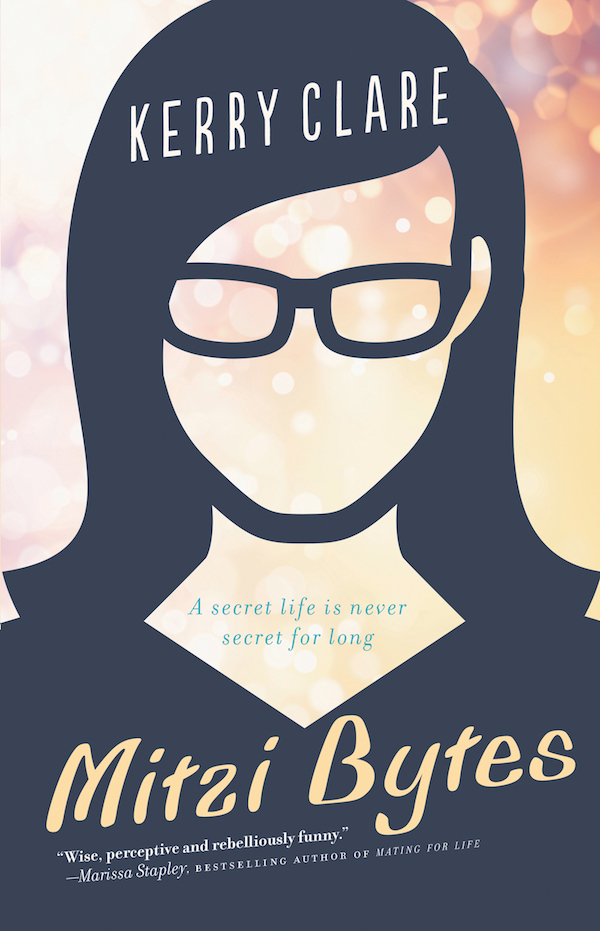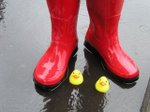March 21, 2011
My Adventures in the Land of Books
Our last vacation was in the land that books forgot, so I was excited to get away to England, the storybook centre of the universe.  Whenever we go to England, we always come back with enough books to fill another suitcase (especially that one time), and this trip was no exception. Though I had less luck in the charity shops than I was hoping for– they used to be rife with 1960s Penguin Paperbacks but they’re all gone now, and now all that’s left are copies of Jenny Colgan novels that came free with a copy of Cosmopolitan. And the children’s books picks were rubbish in the charity shops, but I suppose I can imagine why the second-hand children’s book market might have its challenges.
Whenever we go to England, we always come back with enough books to fill another suitcase (especially that one time), and this trip was no exception. Though I had less luck in the charity shops than I was hoping for– they used to be rife with 1960s Penguin Paperbacks but they’re all gone now, and now all that’s left are copies of Jenny Colgan novels that came free with a copy of Cosmopolitan. And the children’s books picks were rubbish in the charity shops, but I suppose I can imagine why the second-hand children’s book market might have its challenges.
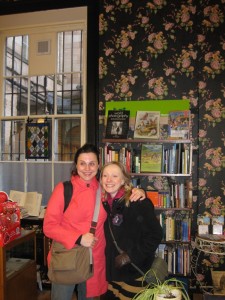 The only books I ended up getting in charity shops were I Am Not Tired and I Will Not Go to Bed by Lauren Childs at the Oxfam in Ilkley, and Tyler’s Row by Miss Read at The Panopticon Shop in Glasgow (which is a charity shop to rebuild a theatre that burned down in 1938, and we sort of got turned off their cause when they made Stuart wait out in the rain with the pram). I also got a Brambley Hedge treasury at the Oxfam in Fleetwood.
The only books I ended up getting in charity shops were I Am Not Tired and I Will Not Go to Bed by Lauren Childs at the Oxfam in Ilkley, and Tyler’s Row by Miss Read at The Panopticon Shop in Glasgow (which is a charity shop to rebuild a theatre that burned down in 1938, and we sort of got turned off their cause when they made Stuart wait out in the rain with the pram). I also got a Brambley Hedge treasury at the Oxfam in Fleetwood.
And though I didn’t end up buying anything, the Oxfam Bookshop in Glasgow was beautiful– 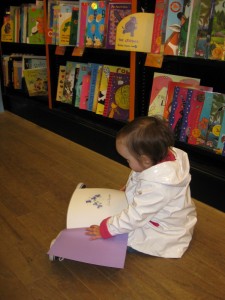 much more boutique than charity shop. It was in the same square as the massive old building (now vacant) that used to house Borders, and I was informed that the loss of that store had been a tragedy– it had been a wonderful place. We also had a good time in the Waterstones in Glasgow, which looked like not much from the outside, but as I rode the escalator down to the lower level, revealed itself to have this hidden middle section between the two floors, sort of like the half-floor in Being John Malkovich, and also a coffee shop, with made my reluctant partner in bookshopping a very happy man. We found the children’s section, and Harriet hurled picture books, and then ate part of a sandwich that she found on the floor.
much more boutique than charity shop. It was in the same square as the massive old building (now vacant) that used to house Borders, and I was informed that the loss of that store had been a tragedy– it had been a wonderful place. We also had a good time in the Waterstones in Glasgow, which looked like not much from the outside, but as I rode the escalator down to the lower level, revealed itself to have this hidden middle section between the two floors, sort of like the half-floor in Being John Malkovich, and also a coffee shop, with made my reluctant partner in bookshopping a very happy man. We found the children’s section, and Harriet hurled picture books, and then ate part of a sandwich that she found on the floor.
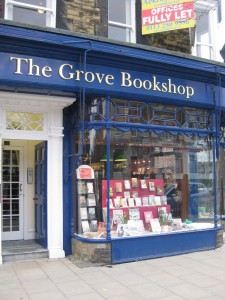 I was thrilled to discover The Grove Bookshop in Ilkley, because independent bookshops are few and far between even in England, and also because this one was bustling. The store has gorgeous window displays, a great selection, and seemed like a thriving community hub. There was a line-up at the till, and another woman there to pick up her special order. I delighted in the selection of Penguin merch, and bought a tote bag, and also Old Filth by Jane Gardam (and now I have to read The Man in the Wooden Hat). I also like The Grove Bookshop in Ilkley because their website boasts a “fast and efficient ordering system [which] means the vast majority of customer orders arrive the following day.”
I was thrilled to discover The Grove Bookshop in Ilkley, because independent bookshops are few and far between even in England, and also because this one was bustling. The store has gorgeous window displays, a great selection, and seemed like a thriving community hub. There was a line-up at the till, and another woman there to pick up her special order. I delighted in the selection of Penguin merch, and bought a tote bag, and also Old Filth by Jane Gardam (and now I have to read The Man in the Wooden Hat). I also like The Grove Bookshop in Ilkley because their website boasts a “fast and efficient ordering system [which] means the vast majority of customer orders arrive the following day.”
We spent our second-last day in London, and had scheduled bookshops a-plenty. I was so happy 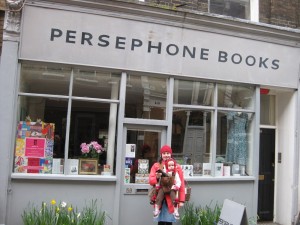 to have a chance to visit Persephone Books, and actually, I’m grateful that budget constraints forced a limit of one book only, or else I would have bought the place out. Their books are so lovely, the shop so homey (but
to have a chance to visit Persephone Books, and actually, I’m grateful that budget constraints forced a limit of one book only, or else I would have bought the place out. Their books are so lovely, the shop so homey (but  crowded! With Persephone books! Can you imagine anything more wonderful?), and I wanted to paw everything. To keep my fellow-travellers happy, I’d pre-selected my purchases so there was less browsing than you might imagine, but if I’d started, I never would have left and would no longer have a family.
crowded! With Persephone books! Can you imagine anything more wonderful?), and I wanted to paw everything. To keep my fellow-travellers happy, I’d pre-selected my purchases so there was less browsing than you might imagine, but if I’d started, I never would have left and would no longer have a family.
I also enjoyed visiting the London Review Bookshop, which was not too far away.  The Cake Shop proved disappointing, sadly, as it was too small to accommodate Harriet’s stroller or Harriet, and was crowded with people discussing existential things who probably didn’t want to listen to Harriet talk about her bum. I bought The Tortoise and the Hare here, though I’d been debating another Rachel Cusk instead, being that day in the thralls of her book The Lucky Ones. And I am a little bit sorry now that I didn’t get the Rachel Cusk books, because she’s so great, and I never found another of her novels in a bookshop the rest of the time we were in England.
The Cake Shop proved disappointing, sadly, as it was too small to accommodate Harriet’s stroller or Harriet, and was crowded with people discussing existential things who probably didn’t want to listen to Harriet talk about her bum. I bought The Tortoise and the Hare here, though I’d been debating another Rachel Cusk instead, being that day in the thralls of her book The Lucky Ones. And I am a little bit sorry now that I didn’t get the Rachel Cusk books, because she’s so great, and I never found another of her novels in a bookshop the rest of the time we were in England.
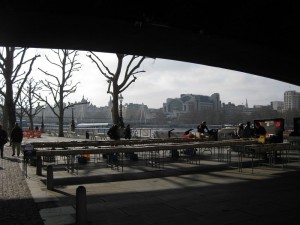 Under Waterloo Bridge, I was happy to see the booksellers again, as well as a bit of sunshine. I didn’t buy anything because nothing immediately struck my eye, and because Stuart and Harriet were being very patient but I didn’t want to push them too far. I am sure if I’d browsed just a little while longer, I would have come up with one treasure or another. (I also wonder if the fact that I found less treasures amongst the used books this trip is because it’s now been a few years since I bought everything Margaret Drabble ever wrote.)
Under Waterloo Bridge, I was happy to see the booksellers again, as well as a bit of sunshine. I didn’t buy anything because nothing immediately struck my eye, and because Stuart and Harriet were being very patient but I didn’t want to push them too far. I am sure if I’d browsed just a little while longer, I would have come up with one treasure or another. (I also wonder if the fact that I found less treasures amongst the used books this trip is because it’s now been a few years since I bought everything Margaret Drabble ever wrote.)
We spent the rest of our London day at The Tate Modern, and I enjoyed exploring 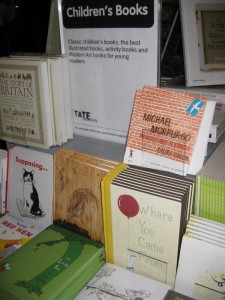 both its bookshops with their wonderful selections of children’s books. It was especially exciting to see Sara O’Leary‘s beautiful Where You Came From on display, amidst some fine company.
both its bookshops with their wonderful selections of children’s books. It was especially exciting to see Sara O’Leary‘s beautiful Where You Came From on display, amidst some fine company.
We spent our last day in Windsor, where I tried and failed to find a bookish treasure in the charity shops (including a wonderfully stocked Oxfam Bookshop, but everything good they had, I had already). We stopped in at the Windsor Waterstones and bought Harriet The Gruffalo and Alfie’s Feet, and I tried and failed to find a Rachel Cusk novel to buy, just as I would do the next day at the airport. Regrets, I’ve had a few.
But not too many. Our trip was full of bookish wonder. I arrived home with a most respectable stack, and what’s more, I’ve since read each and every one of them.
January 20, 2011
The kids books we've been enjoying lately
 “There’s no doubt that the young adult novel is Fitch’s true metier”, writes Deirdre Baker in her Toronto Star review of Sheree Fitch’s latest book Pluto’s Ghost, and I have no truck with that, because in our house Fitch is queen of the board book (we discovered her via Kisses Kisses Baby-O), but her picture books own our hearts as well. In particular Mabel Murple, which is the reason my daughter knows at least one colour. First published in 1995 and recently re-issued with vibrant new illustrations, Mabel Murple is the tongue-twisting story of a purple girl, all dreamed up. A skateboarding scallywag, skiing speed demon (on purple snow) with a purple teddy bear called Snickernickerbox (and he snores). A story of merry motorbiking through muddy purple puddles, and a delectable-sounded condiment called Mabel Murple’s purple maple syrple. A whimsical singsong, adored by everybody in our family.
“There’s no doubt that the young adult novel is Fitch’s true metier”, writes Deirdre Baker in her Toronto Star review of Sheree Fitch’s latest book Pluto’s Ghost, and I have no truck with that, because in our house Fitch is queen of the board book (we discovered her via Kisses Kisses Baby-O), but her picture books own our hearts as well. In particular Mabel Murple, which is the reason my daughter knows at least one colour. First published in 1995 and recently re-issued with vibrant new illustrations, Mabel Murple is the tongue-twisting story of a purple girl, all dreamed up. A skateboarding scallywag, skiing speed demon (on purple snow) with a purple teddy bear called Snickernickerbox (and he snores). A story of merry motorbiking through muddy purple puddles, and a delectable-sounded condiment called Mabel Murple’s purple maple syrple. A whimsical singsong, adored by everybody in our family.
I recently checked out Mem Fox’s website, and found out that she’d been to dinner at Judith  Viorst’s not too long ago, and the idea of such a dinner party makes me a bit in love with the whole wide world. I’ve been getting a similar feeling from Viorst’s book Sunday Morning for ages now, with its amazing silhouette drawings by Hilary Knight. The drawings are what Harriet likes best about the book, and how she can pick out the cat and owl, and see all the rooms in the house at once with the fourth wall removed. She doesn’t get the jokes and the mischief yet though, which are my favourite parts. The boy who wakes up his brother with the noise like a soft machine gun, and how he walks around the house saying, “God, I’m hungry. God, I’m hungry,” because there are no grown-ups around to tell him not to say god. The fights with his brother, which are settled with a karate chop, and how they use their mother’s dress from the hamper to sop up spilled milk.
Viorst’s not too long ago, and the idea of such a dinner party makes me a bit in love with the whole wide world. I’ve been getting a similar feeling from Viorst’s book Sunday Morning for ages now, with its amazing silhouette drawings by Hilary Knight. The drawings are what Harriet likes best about the book, and how she can pick out the cat and owl, and see all the rooms in the house at once with the fourth wall removed. She doesn’t get the jokes and the mischief yet though, which are my favourite parts. The boy who wakes up his brother with the noise like a soft machine gun, and how he walks around the house saying, “God, I’m hungry. God, I’m hungry,” because there are no grown-ups around to tell him not to say god. The fights with his brother, which are settled with a karate chop, and how they use their mother’s dress from the hamper to sop up spilled milk.
 The Owl and the Pussycat with Stephane Jorisch’s illustrations is deeply weird, and weirdly imagined. Tough cat arrives from the wrong side of the tracks, and masses look on with stone faces, mostly because they’re all wearing masks. The owl and the pussy cat are oblivious to the spectacle they are, and decide to be married for too long they have tarried. Sailing away to the land where the bong trees grow, they finally find a place where a pairing such as theirs is accepted, and they end up dancing by the light of the moon, the moon, the moon. These illustrations are just subtly sinister enough that a child will never stop being fascinated by them, but they’ll also never be entirely sure why they are.
The Owl and the Pussycat with Stephane Jorisch’s illustrations is deeply weird, and weirdly imagined. Tough cat arrives from the wrong side of the tracks, and masses look on with stone faces, mostly because they’re all wearing masks. The owl and the pussy cat are oblivious to the spectacle they are, and decide to be married for too long they have tarried. Sailing away to the land where the bong trees grow, they finally find a place where a pairing such as theirs is accepted, and they end up dancing by the light of the moon, the moon, the moon. These illustrations are just subtly sinister enough that a child will never stop being fascinated by them, but they’ll also never be entirely sure why they are.
Finally, we love, love Elephant and Piggie. So does everybody, of course, but better late to the party  than never. The latest in the series We Are in a Book (which I discovered via Nathalie Foy) does not disappoint. Gerald is thrilled to discover that he and Piggie are actually in a book (“That is so cool!”) until he learns that the book will end. That all books end. So together, he and Piggie come up with a plan to prolong their metafictional existences. It’s wonderful, and Harriet finds the simple language and exaggerated gestured in the illustrations absolutely hilarious. Stuart and I have about as much fun reading this to her as she has listening to us.
than never. The latest in the series We Are in a Book (which I discovered via Nathalie Foy) does not disappoint. Gerald is thrilled to discover that he and Piggie are actually in a book (“That is so cool!”) until he learns that the book will end. That all books end. So together, he and Piggie come up with a plan to prolong their metafictional existences. It’s wonderful, and Harriet finds the simple language and exaggerated gestured in the illustrations absolutely hilarious. Stuart and I have about as much fun reading this to her as she has listening to us.
January 10, 2011
The Bob Dylan of children's authors
“This may sound disingenuous, but here’s the thing: When you are a small child besotted with books, the books themselves– especially the ones you love the best–are autonomous things, concrete yet abstract, like the stuffed animals and building blocks that help you travel to places where only you can go. At bedtime, you don’t ask your mom, “Read me some E.B. White.” You ask for Stuart Little, or Charlotte and Wilbur. You ask for a dog story; for Pippi, Babar, or–nowadays–Toot and Puddle. Your favourite characters–you know them. From a mile away, you could spot the Man in the Yellow Hat, Mrs. Mallard, Olivia or Ferdinand the bull; but H.A. Rey, Robert McCloskey, Ian Falconer, and Munro Leaf–who the heck are they? Authorial celebrity is sabotaged yet further when picture books lose their jackets… they shed their authors’ biographies as well. Many prolific children’s authors are also prone to changing dance partners–that is, illustrators– making their books even harder to see as distinctly their own. (Dr. Seuss may be the exception to this rule. Children become aware of him as a uniquely creative individual, perhaps because they hear their parents call the guy “a genius”. He’s the Bob Dylan of children’s authors, too eccentrically, definitively… well, Seussian… to be confused with anyone else.) “– Julia Glass, “Roar and More” from Bound to Last: 30 Writers on their Most Cherished Books.
December 29, 2010
Comfort and Joy
 One of the reasons I’ve had such a lovely holiday (which I’m still having, actually) is that I received India Knight’s new novel Comfort and Joy, freshly imported from the UK. A fortunate thing, because it’s a Christmas book, and it would have been strange to read it in April or October, but to spend Christmas and Boxing Days stuck between its covers was absolutely perfect. Not least of all because its covers are so lovely– designed by Leanne Shapton of Important Artifacts… fame. And oh golly, those endpapers with sprigs of holly. Of course the story too, and I love all of India Knight’s work, and how she channels Nancy Mitford, comic fiction at its finest, her self-conscious send-up of the English middle class, and that her novels read like her newspaper columns but all spliced together. Referencing Barbara Pym on one page, and Grant Mitchell on another, and I’m not sure the world gets more perfect than that. I thoroughly enjoyed this novel.
One of the reasons I’ve had such a lovely holiday (which I’m still having, actually) is that I received India Knight’s new novel Comfort and Joy, freshly imported from the UK. A fortunate thing, because it’s a Christmas book, and it would have been strange to read it in April or October, but to spend Christmas and Boxing Days stuck between its covers was absolutely perfect. Not least of all because its covers are so lovely– designed by Leanne Shapton of Important Artifacts… fame. And oh golly, those endpapers with sprigs of holly. Of course the story too, and I love all of India Knight’s work, and how she channels Nancy Mitford, comic fiction at its finest, her self-conscious send-up of the English middle class, and that her novels read like her newspaper columns but all spliced together. Referencing Barbara Pym on one page, and Grant Mitchell on another, and I’m not sure the world gets more perfect than that. I thoroughly enjoyed this novel.
I received a few other books for Christmas (Started Early, Took My Dog, The Torontonians, Pleased to Meet You) but I’m saving these for the New Year. In the meantime, I am reading up the unread books on my shelf that are unpressing and therefore I might never get around to reading ever. And this has been a most rewarding experience– it’s why I read Our Spoons Came From Woolworths, and then Andrew Pyper’s amazing Lost Girls, Almost Japanese by Sarah Sheard, and Touch the Dragon by Karen Connelly. I’m now reading The Heat of the Day by Elizabeth Bowen, which I’ve been putting off and putting off, because although I enjoyed The House in Paris last Fall, I also remember that it was difficult and sometimes frustratingly abstruse. Once I’ve conquered it, however, I am going to attempt to read a little-known work called The Girl With the Dragon Tattoo. But then again, maybe I won’t.
In picture book news, we gave Harriet We Are In a Book (An Elephant and Piggie Book by Mo Willems), The Book About Moomin, Mymble and Little My by Tove Jansson, and The Owl and the Pussycat. My life is now officially complete, because a friend gave us The Jolly Postman. Other amazing books include The Quiet Book by Deborah Underwood, the terrifyingly wonderful Mixed Beasts by Kenyon Cox, and But No Elephants by Jerry Smath.
Our days have been a mix of a whole lot of nothing and a whole lot of everything, friends, togetherness, and copious amounts of chocolate. We are infinitely grateful that Stuart now works in an office that closes for the holidays, as everything is better when he is around, and he’s around all the time. We are also very much listening to the CDs received in our family for Christmas: Dar Williams’ Many Great Companions, The Essential Paul Simon, and Elizabeth Mitchell Sunny Day. Each one is very, very good.
December 21, 2010
Illustrated literary allusions
 Seriously, my head went on vacation three days ago, so please indulge me a little here. Lately, I’ve been obsessed with identifying illustrated literary allusions in picture books. The Ahlberg‘s are all over this, the baby in Baby’s Catalogue actually reading his own copy of Baby’s Catalogue. Elsewhere in the book, Baby’s Daddy is reading old school baby expert Hugh Jolly’s Book of Child Care. In another Ahlberg book, the sweet but kind-of-disturbing Bye Bye Baby, the old Uncle is reading an orange Penguin paperback, but no amount of examination has managed to decipher which one.
Seriously, my head went on vacation three days ago, so please indulge me a little here. Lately, I’ve been obsessed with identifying illustrated literary allusions in picture books. The Ahlberg‘s are all over this, the baby in Baby’s Catalogue actually reading his own copy of Baby’s Catalogue. Elsewhere in the book, Baby’s Daddy is reading old school baby expert Hugh Jolly’s Book of Child Care. In another Ahlberg book, the sweet but kind-of-disturbing Bye Bye Baby, the old Uncle is reading an orange Penguin paperback, but no amount of examination has managed to decipher which one.
Harriet and I both delight in Jorge Uzon’s Go Baby Go when the baby in the book “reads” Teddy Jam’s Night Cars. We also have a book called Book by Kristine O’Connell George, whose illustrations by Maggie Smith show the child clearly reading Richard Scarry’s The Bunny Book. Except that Scarry is uncredited– I wonder if it’s more tribute than plagiarism? Though wouldn’t a more fitting tribute be to have his name on it, hmm?
Updated: We just read Marjorie Flick’s Ping, followed by Sarah Garland’s Going to Playschool in which the children are being read aloud from a book that is quite clearly Marjorie Flack’s Ping. Amazing! What are the odds of these two books coming home from the library with us together?
December 17, 2010
Old picture books we love
In November we started going to the Lillian H. Smith Library, whose building is new but whose collection dates back to Gutenberg (or thereabouts). The highlight of this has been discovering new-to-us picture books that are decidedly not new to anyone else. I’ve been surprised at how many of these I’ve brought home have been wonderful, though I suspect their wonderfulness is the reason they’re still lingering on library shelves. Timelessness is a tricky recipe, however, and I’m still not sure how it is concocted.
 One writer who has managed it is Marjorie Flack, who has written the Angus books. Angus gets lost, finds some ducks, has an altercation with a cat. The milkman makes an appearance, so we know that we’ve gone back in time a little bit– these books were first published in the 1930s. But not so far back in time that the pages are dusty. Flack develops a fabulous momentum by having sentences continue onto the following page, she has great fun with all kinds of sounds, and poor little Angus is a just a tiny bit dumb that even Harriet can outsmart him– she liked the part where the cat was hiding behind the corner, Angus couldn’t see it, but she could.
One writer who has managed it is Marjorie Flack, who has written the Angus books. Angus gets lost, finds some ducks, has an altercation with a cat. The milkman makes an appearance, so we know that we’ve gone back in time a little bit– these books were first published in the 1930s. But not so far back in time that the pages are dusty. Flack develops a fabulous momentum by having sentences continue onto the following page, she has great fun with all kinds of sounds, and poor little Angus is a just a tiny bit dumb that even Harriet can outsmart him– she liked the part where the cat was hiding behind the corner, Angus couldn’t see it, but she could.
I picked Minou off the shelf, because it reminded me a bit of Madeline. Its author is  Francoise Seignobosc (1900-1961), who has a bit of biographical detail here. Minou is a small white cat who has gone missing, and the story is about the small girl who owns here going around Paris to ask if anyone has seen her Minou. This book went over particularly well, because we read it at the same time that Harriet had learned to hold out her outstretched hands and look longingly whenever she was searching for something. We look for Minou at the cheese shop, the newspaper stand, the barber, the bakery, and then (spoiler alert) we learn that Minou was last seen on a barge and she’s gone off to travel the world. But we’re assured that she’ll soon come to Paris, because everybody does.
Francoise Seignobosc (1900-1961), who has a bit of biographical detail here. Minou is a small white cat who has gone missing, and the story is about the small girl who owns here going around Paris to ask if anyone has seen her Minou. This book went over particularly well, because we read it at the same time that Harriet had learned to hold out her outstretched hands and look longingly whenever she was searching for something. We look for Minou at the cheese shop, the newspaper stand, the barber, the bakery, and then (spoiler alert) we learn that Minou was last seen on a barge and she’s gone off to travel the world. But we’re assured that she’ll soon come to Paris, because everybody does.
 I have loved loved loved Don Freeman for my whole life (mostly because of Corduroy and Tilly Witch), but I had never read Quiet! There’s a Canary in the Library. The story is mildly psychedelic and totally wonderful– a small girl called Cary goes to the library, and starts fantasizing that she has a library of her own, with a special day for animals to come visit. Everything starts out okay– the door is a bit wide for the elephant, the giraffe has to duck, but the lion behaves, and the monkeys stay in line, but when a bunch of mice sneak in because she’s left the door open, things spiral out of control. Luckily, the canary saves the day, and Cary comes out of her fantasy with only a modicum of embarrassment. I loved it, and Harriet liked the animals, and I particularly loved the narrative mostly constructed of a wide variety of greetings, as one animal comes into the library after another– a useful lesson that’s buried underneath a story that is lots of fun.
I have loved loved loved Don Freeman for my whole life (mostly because of Corduroy and Tilly Witch), but I had never read Quiet! There’s a Canary in the Library. The story is mildly psychedelic and totally wonderful– a small girl called Cary goes to the library, and starts fantasizing that she has a library of her own, with a special day for animals to come visit. Everything starts out okay– the door is a bit wide for the elephant, the giraffe has to duck, but the lion behaves, and the monkeys stay in line, but when a bunch of mice sneak in because she’s left the door open, things spiral out of control. Luckily, the canary saves the day, and Cary comes out of her fantasy with only a modicum of embarrassment. I loved it, and Harriet liked the animals, and I particularly loved the narrative mostly constructed of a wide variety of greetings, as one animal comes into the library after another– a useful lesson that’s buried underneath a story that is lots of fun.
November 18, 2010
Behind every TPL Librarian…
 In my experience, behind every Toronto Public Library librarian, there is a little bit of awesome. Take TPL Librarian Martha Baillie for instance, whose awesome behind her is the acclaimed and wondrous The Incident Report. I’ve already mentioned our local librarian Mariella, who goes around the world telling stories, but we get to hear her in our neighbourhood every week. A whole lot of awesome, I thought, but it turned out to not even be the half of it.
In my experience, behind every Toronto Public Library librarian, there is a little bit of awesome. Take TPL Librarian Martha Baillie for instance, whose awesome behind her is the acclaimed and wondrous The Incident Report. I’ve already mentioned our local librarian Mariella, who goes around the world telling stories, but we get to hear her in our neighbourhood every week. A whole lot of awesome, I thought, but it turned out to not even be the half of it.
For the last month, we’ve been attending the toddler program at the Lillian H. Smith branch, being just on the verge of having outgrown Spadina Road’s Baby Time. And we love it– Harriet gets to run around, gaze at big kids, misbehave, sing songs, play games, do the beanbag song, and hear stories read by Joanne, who we adored from the get-go. Back at Spadina, I was telling Mariella about how much we were enjoying it, and she asked me if we’d read Joanne’s books.
branch, being just on the verge of having outgrown Spadina Road’s Baby Time. And we love it– Harriet gets to run around, gaze at big kids, misbehave, sing songs, play games, do the beanbag song, and hear stories read by Joanne, who we adored from the get-go. Back at Spadina, I was telling Mariella about how much we were enjoying it, and she asked me if we’d read Joanne’s books.
“Joanne has books?” I asked. Of course she does, and Mariella directed us to Our Corner Grocery Store and City Alphabet. The marvelous Joanne is actually Joanne Schwartz, who is as talented at writing books as she is at reading them. And I’ve really enjoyed them, her text perfectly complementing the images by photographer Matt Beam and illustrator Laura Beingessner. Both are generically urban enough to be from anywhere, but I can’t help but see Toronto on every page. Both books, in very different ways, celebrating urban communities and particular uniquenesses that characterize the places where we live.
November 17, 2010
Bringing Books To Life
Tonight I gave a talk entitled “Bringing Books to Life” to a friend’s Early Childhood Education class in Literacy at Ryerson University. I knattered away about stuff and such, and read a bunch of stories. Concluding with one of Mem Fox’s many quotable quotes:
Reading isn’t merely being able to pronounce the words correctly, a fact that surprises most people. Reading is being able to make sense from the marks on the page. Reading is being able to make the print mean something. Reading is getting the message.
Books Read
- Sunday Morning by Judith Viorst
- Sleeping Dragons All Around by Sheree Fitch
- I Can Read With My Eyes Shut by Dr. Seuss
- Where Is the Green Sheep by Mem Fox
- Bubble Trouble by Margaret Mahy
Books Mentioned
- Reading Magic by Mem Fox
- “Sharing the Mayhem” from Ex Libris by Anne Fadiman
- Better Than Life by Daniel Pennac
- How the Heather Looks by Joan Bodger
- The Crack in the Teacup by Joan Bodger
November 16, 2010
Penny Dreadful by Laurel Snyder
 On the rare occasions I read YA, it will be a book I used to love, or a book that refers to books I used to love (such as A Wrinkle In Time, which was why I read Rebecca Stead’s beautiful When You Reach Me). Of course, as Laurel Snyder’s latest novel Penny Dreadful is brand new, I read it for the latter reason. On her blog she’s posted a list of books loved by her protagonist, books referred to in the text– Emily of New Moon, Little Women, Betsy-Tacy etc. etc. And this gratuituous bookishness convinced me that this was a book I had to read.
On the rare occasions I read YA, it will be a book I used to love, or a book that refers to books I used to love (such as A Wrinkle In Time, which was why I read Rebecca Stead’s beautiful When You Reach Me). Of course, as Laurel Snyder’s latest novel Penny Dreadful is brand new, I read it for the latter reason. On her blog she’s posted a list of books loved by her protagonist, books referred to in the text– Emily of New Moon, Little Women, Betsy-Tacy etc. etc. And this gratuituous bookishness convinced me that this was a book I had to read.
I wasn’t sold short– we learn on page 5 that Penelope has just finished an Anne of Green Gables book and is having trouble deciding what to read next. Later she wonders if a situation is like a disturbing book with an innocuous cover, “like Bridge to Terabithia“. Penelope Gray’s biggest problem is that her life is nothing like the characters in the books she devours, and she makes a wish that things could get more interesting…
And then they do, but not quite in the way she’d imagined. Through a series of events, her family ends up moving to a small town and encountering a cast of wacky characters, and what with all the wacky characters, a winding river, and the wishing well that started it all, Penny becomes assured of her place in the narrative that is her life. That she will find the hidden treasure after all, and save the day etc. Except that she’s not a character in a book (except that she is a character in the book. Fun!), and has to learn that even if things don’t work out to a perfect conclusion, life can still be okay.
Penny Dreadful is a timeless, lovely middle-grade novel with much bookish appeal. Made very rich by and a fitting tribute to the marvelous works it alludes to.
October 20, 2010
Harriet has a meta moment
 Okay, I’ll admit to not being exactly capitivated by the plots, but 17 month old Harriet is absolutely obsessed with the Hello Baby Board Book series by Jorge Uzon. These books have only lived in our house for a very short period, but Harriet keeps taking them off the shelf and demanding they be read to her. When she isn’t demanding they be read to her, she is struggling to walk around the house holding all four books at the very same time. Clearly, Uzon has found an audience for his beautiful photography.
Okay, I’ll admit to not being exactly capitivated by the plots, but 17 month old Harriet is absolutely obsessed with the Hello Baby Board Book series by Jorge Uzon. These books have only lived in our house for a very short period, but Harriet keeps taking them off the shelf and demanding they be read to her. When she isn’t demanding they be read to her, she is struggling to walk around the house holding all four books at the very same time. Clearly, Uzon has found an audience for his beautiful photography.
Our favourite part of all the books, however, is in Go Baby, Go! when the baby discovers another baby within the pages of his book. And the amazing thing about this is that he has discovered the Night Cars* baby! We love Night Cars, and pointing to the baby (who, when he finally falls asleep, has an adorable tendency to stick his bum into the air) is Harriet’s favourite part of the book (except for the fire truck). So to see the baby in her book pointing to the baby in her book, and then to point to that baby herself– I think Harriet is discovering that the bounds between fiction and reality are ever-blurry. Or maybe I’m just projecting.
*Do you know Night Cars? The absolutely gorgeous urban bedtime book by Teddy Jam, who was aka the late novelist Matt Cohen? I bought this book for Harriet when I was four months pregnant, and signed the inside cover “from Mommy and Daddy”, which was kind of amazing then. And still is. Its rhymes punctuate our days– “Garbage man, garbage man, careful near that dream. It could gobble up your garbage truck, and then where would you be?” Also notable for being a book about *Daddy*. And donuts.
Anyway, I didn’t know this book either until I heard Esta Spalding reading it as part of Seen Reading’s Readers Reading almost two years ago. And I am very glad I did.

